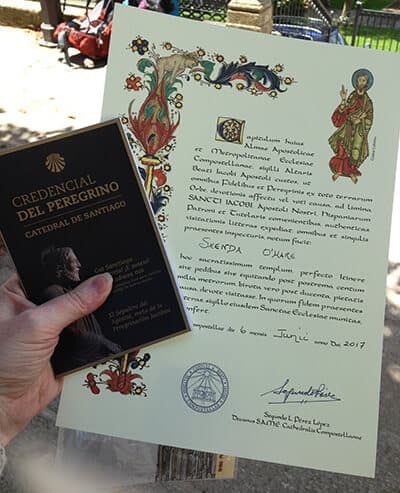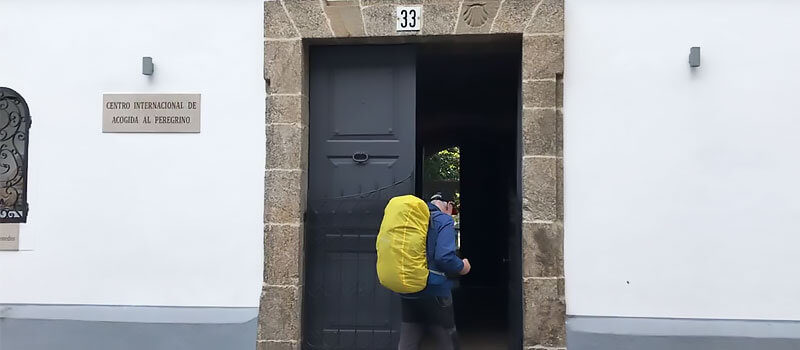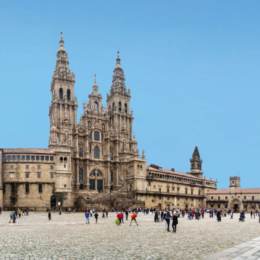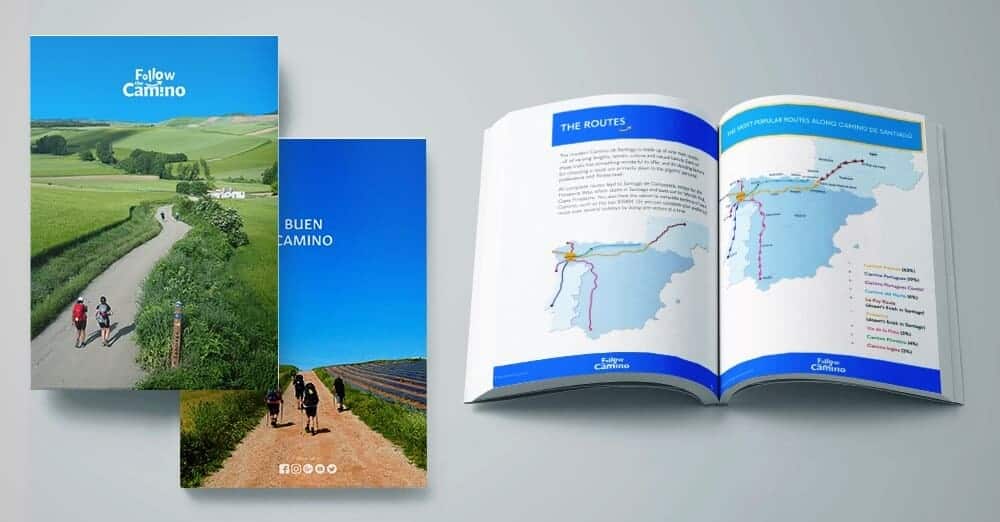The first port of call for most pilgrims arriving in Santiago de Compostela is the magnificent Cathedral of Santiago. After a visit to the Cathedral and the celebratory hugs with friends, a trip to the pilgrim’s office Santiago is next on the list.
Pilgrim’s Reception Office, Santiago de Compostela
The pilgrim’s office is where pilgrims receive their official Compostela or certification that they have completed a pilgrimage to Santiago de Compostela. These pilgrims then join the ranks of the millions who, for more than 1000 years, have been officially recognised for undertaking their journeys to the tomb of the Apostle St. James.
Address, Contact Information and Opening Time




* The closing time may be advanced up to 60 minutes earlier according to the influx of pilgrims.

What is The Compostela Certificate
The Compostela or Compostelana is a certificate of accomplishment given to pilgrims on completing the Way of St James, an ancient pilgrimage with its roots in the 9th century.
How to Get Your Compostela
To get your Compostela certificate you have to go in person to the pilgrim’s office. It’s important to know that whether you go on the Camino with a group or not, this is something personal, no one can do it on your behalf.
In 2023, over 440,000 Compostela certificates were issued by the pilgrim’s office in Santiago de Compostela, and this is a number that increases year-on-year.
To avoid long queues, mainly during peak season (July and August), and looking towards the Holy Year 2027, the pilgrim’s office installed a new system for pilgrims to get their Compostela certificate.
Ticket Machine
Once you get to the pilgrim’s office you need to find a ticket machine located in the waiting room. The ticket has a number to be attended and a QR code. Then you have two options:
- You can stay in the pilgrim’s office waiting room and look at the screen to check the number that has been called and the number of the counter where you’ll be attended.
- Also, you can opt to go outside and have a drink while you wait. You can keep an eye on the screen by scanning the QR code in your ticket with your smartphone. It will show the current number that is being attended and your number.
- Give yourself time to come back to the pilgrim’s office before your number is called, your number can be assigned to other pilgrims if you’re absent when you’re called. Once you are back at the pilgrim’s office, have a look at the screen to know the number of the counter where you’ll be attended.
Important note:
Due to the number of pilgrims arriving every day to Santiago, the pilgrim’s office issues a number of daily tickets first thing in the morning. We recommend you to go to the office very early in the morning to guarantee you will get your Compostela on that day. Always remember to be kind and patient with the pilgrim’s office staff.
How is the Compostela Certificate Issued?

When your number is displayed on the pilgrim’s office screen, you’ll also see the number of the counter were your Compostela will be issued. Walk to the table assigned.
An official will thoroughly check your credentials with its dates and stamps to determine that your pilgrimage was undertaken in accordance with the rules of the Cathedral.
You will be asked to fill out a form stating your name, where you are from, where you started your pilgrimage and your reason for undertaking a pilgrimage. When the official is happy with your paperwork, he or she will issue with your Compostela, Certificado, and/or Certificate of Distance.
The numbers of all pilgrims arriving at the Pilgrim Office Santiago during the previous 24 hours will be read out during the Pilgrim’s Mass at 12:00 and 19:30 in the Cathedral. The priest will also give the nationalities and starting points for these pilgrims.
How to Qualify For a Compostela
To qualify for a Compostela, a pilgrim must show proof of fulfilling the following criteria:
- The pilgrimage must be undertaken for religious or spiritual reasons or in “an attitude of search”.
- A pilgrim must collect “sellos” or stamps on a “Credencial del Peregrino” which is issued by the Cathedral de Santiago or a body authorised by the Cathedral (Follow The Camino supplies this as a part of your pilgrim pack!).

- The stamps must be collected twice per day if the pilgrim is travelling only the last 100 km by foot or horseback, or the last 200 km on bike. If travelling for longer distances, one stamp per day is adequate.
- The Camino can be undertaken in stages of any length in order to earn a Compostela. It is not uncommon for pilgrims to walk consecutive stages over many years in order to reach Santiago de Compostela.
- This is perfectly acceptable as long as the stages are completed in proper chronological and geographical order. The pilgrim must also get a stamp with the date at the completion point of each stage and again at the same point when they resume their pilgrimage.
Muxia and Finisterre Way
Muxia and Finisterre Way are distinct routes that diverge from the traditional Camino de Santiago, each offering a unique pilgrimage experience. While both culminate at the picturesque coastal destinations of Muxia and Finisterre on the Galician coast, they are considered separate paths for the purposes of qualifying for the Camino Compostela Certificate. Pilgrims seeking this certification must complete a minimum of 100 kilometers on foot or 200 kilometers by bicycle along one of the recognized routes leading to Santiago de Compostela. Muxia and Finisterre Way, although captivating extensions of the Camino journey, require their own separate pilgrimages to be considered for the Compostela.
How to Get Your Camino Passport “Credencial del Peregrino”
You can get your pilgrim’s credential by requesting it in person at the Pilgrim’s Office or other institutions authorised by the Cathedral of Santiago for their distribution, such as parish churches, Associations of Friends of the Way of St. James, pilgrim hostels, confraternities, etc.
In Spain and abroad, some associations related to the pilgrimage have been authorised to distribute their own Credenciales with a reference to the goal of the pilgrimage at the Cathedral of Santiago. If you have booked with us, you’ll receive your pilgrim’s credential as a part of the Follow the Camino Pilgrim’s Pack that we sent to our customers, so you don’t need to worry about it.
Compostela Certificate
The Compostela is issued in Latin. The recipient’s name is also written in Latin if a Latin form of their name exists. The English translation of the Compostela is shown below.
The Chapter of this Holy Apostolic and Metropolitan Cathedral of Compostela, custodian of the seal of the Altar of St. James, to all the Faithful and pilgrims who arrive from anywhere on the Orb of the Earth with an attitude of devotion or because of a vow or promise make a pilgrimage to the Tomb of the Apostle, Our Patron Saint and Protector of Spain, recognises before all who observe this document that: …..{Name}…. has devotedly visited this most sacred temple with Christian sentiment (pletatis causa).

In witness thereof, I present this document endorsed with the seal of this same Holy Church.
Issued in Santiago de Compostela on ….{Day}…. of ….{Month}…. year of our Lord ….{Year}….
Deputy Canon for Pilgrims
Other Camino Credentials: Certificate of Distance

For those qualifying for a Compostela, the Pilgrim’s Office will also issue a Certificate of Distance which details the starting place and date of a person’s pilgrimage as well as the completion date and the route they travelled.
These documents cost €3 and can be obtained in conjunction with the Compostela, which is free.
Certificado
For those not undertaking the Camino for religious or spiritual reasons, the Pilgrim’s Office Santiago will issue a Certificado. The Certificado is a document that acknowledges the completion of the Camino and has the same distance requirements as the Compostela.
History of the Compostela
Badges in the shape of scallop shells formed the first accreditation of pilgrims arriving in Santiago. However, these were easily forged and were soon being sold at the entrances to the city. To curb this trade, the Pope threatened to excommunicate the forgers.
The prelates of Compostela then developed and began issuing a more secure form of accreditation. This consisted of a “cartas probatoria” or evidentiary letter. These were being issued by the 13th century and were the direct forerunners of the modern Compostela.
Though hugely popular during the middle ages, the pilgrimage to Santiago began to decline from the 16th century onward. However, the Camino experienced a revival in the late 20th century which forced the Cathedral to re-evaluate once again the security of the Compostela.
This was undertaken to ensure that, in the fast-moving modern world, those receiving the Compostela had indeed completed a pilgrimage. The new rules regarding the Compostela defined what manner of transport and distances constitute a pilgrimage.
The Digital Compostela – A New Pilgrim’s Credential
In 2021, the Cathedral de Santiago introduced a digital rendition of the Pilgrim’s Credential, commonly referred to as the pilgrim’s passport, departing from the traditional paper format. This initiative signifies a dual purpose: a stride towards integrating modern technology into the Camino de Santiago and a proactive response to the challenges posed by COVID-19. You can find more about it here.






-Camino-de-Santiago-260x260.jpg)

